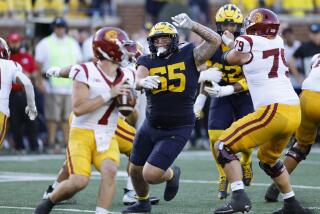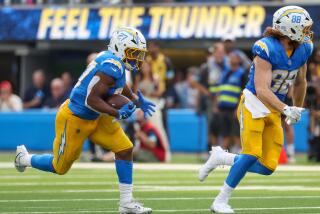Sometimes, Pain Wins
It’s amazing how fast things can go from great to horrible. That’s what happened to me this season.
The high for me was after we beat New England. We were 4-0 and had beaten the Super Bowl champs. It was our fourth game and I had three sacks already and an interception. Everything was really good. I was feeling sound. I was faster. I was quicker. I was smarter.
And I was headed for a fall.
First, let me say this: I’ve had some groin pain for a year or two off and on. It comes at different times. Groin and back injuries, you don’t want those. They come and they stay. They have their own mind where they don’t like to relocate and go away easily. They pretty much shack up and stay.
My groin injury happened in the fifth week, at Denver. It flared during practice the week before the game. It was just like an irritation. I was like, OK, I’ve been playing really hard and going after it. Maybe I’m a little tired. So I went into the game a little hesitant, a little timid. Yeah, I was timid, guarding my leg from my physical condition.
But it was time to play. You’ve got to take your seat belt off when it’s time to play.
On the first play, it was a run my way. I was keeping contain, making sure the guy didn’t get outside me, and Bronco running back Clinton Portis started to cut inside. I tried to throw my man to the left and run right. When I did that it felt like a tear, just like paper tearing. But it was inside my stomach, in my lower abdomen. What I did was just kind of bend over in the middle of the play, like, oh, whoa. I knew I was hurt then. I knew it was an abdominal injury, and I knew it wasn’t going to be good.
I tried to play that half. I came in and out. I never really finished the half. I’d play a couple of plays here and there. Finally at halftime, I was trying to walk off the field, but I was pretty late. My trainer walked up to me and was like, “Man, you don’t look good. You all right?” I was like, “Naw, man, I can’t lift my legs.”
And he said, “We can see.”
So he brought me in there and had me lie on the table. He gave me a couple of tests, and it absolutely shut down. The whole area. I could not lift my leg up. So he said, “Hey, the best thing to do is have shots right now. Try and see if you respond.”
So they got ready to give me two shots in my groin. My groin had pulled in compensation for my abs. They’re all connected. Once you pull one thing, the body responds and tries to compensate. It makes you stronger on the other side, but that’s too much pressure for the abs to handle because the groin is weak. It’s a compensation process that makes everything basically shut down.
Finally, I said, “Gimme those shots.” And they gave them to me.
It’s pretty tough, not only because they had to give me a shot, but it’s not a surface shot. It’s, “OK, this hurts? OK, that’s where it’s at? Now, we’re going to shoot you right there.” They’re going to touch that same area where it hurts. They’re not going to touch the top area, they’re going to get to the core of it and inject. Your injuries are usually like an inch or two under your skin. They stick the needle in that far. And two shots? The first one was hell, but the second one was purgatory. It’s like, oh my God.
It’s as if I have my 3-year-old daughter’s legs and my chest. And in your mind you’re still telling yourself, “I’ve got a couple more minutes in halftime. I’m gonna play. I’m gonna play. I’m gonna play. I’m gonna be out there for the third quarter.”
And your body is screaming at your mind, like, “Are you crazy? I have nothing to give you. You go by yourself.” You’re dealing with this tug of war.
And then you’re looking at your teammates. You don’t want to let them down. They’re all asking you, “You all right?” And you keep saying, “Yeah, I’m fine.”
You’re lying to everybody. The trainers want you to be on the field, but at the same time they want you to be sound. They’re caught in that Catch-22. It’s not a good position. That’s where all that pressure kicks in because you want to push yourself harder than you can go.
I didn’t go back into that game. The groin injury bothered me all season and kept me out of the next three games. But there was this other thing too. Something I didn’t quite recognize. It would happen in my high-calf, lower-knee area. If I got hit or cut on a play where a guy blocked me on the legs, then it would become numb for about two minutes. It would be numb, tingle and sting for two minutes. Then it would go away.
The problem with that is, if a team was going no-huddle or a team lines up within that two minutes -- which they do -- then for that one play I’m in trouble. It’s kind of like I’m out there with one leg on that one play. But then the feeling snaps back, usually on the second play, and I’ll be fine. It happens a couple of times a game.
I could feel it coming. I’d try to get up and then, boom, it would just buckle. Aw, here we go -- two plays. That’s when you’re looking at the other team: Please, run to the other side. Please, go over there. Try to buy you a play. But it doesn’t happen. They usually come right at you.
A lot of times you have to fake that you’re not hurt. After the first game, we’re all actors. No one’s feeling good. It’s a situation where cosmetically you may look fine, you may look like a person, but internally you’re broken down.
From the first game on, everyone is cosmetic. You feel fine. Your body can adapt to the situation. So you may not go to the training room with an injury, but you know my arm hurts, my shoulder’s sore. But you don’t walk into the training room when you wake up early in the morning and say, “I’m sore.” They’ll probably shut the door in your face. Or you’ll be kicking yourself for wasting valuable sleep time. You just don’t get treatment when you’re sore. That’s not enough.
We don’t have a job where you can take a sick day. You’ve got a cold? You’re practicing. You’ve got the flu? You’re probably practicing. You’ve got pneumonia? Well, it’s more than likely you’re not going to make it.
The only thing that got us out of practice when I played in Buffalo was lightning. In Buffalo, when it started to rain, we’d all look around and be like, “I hope I see one lightning rod. If you see one, we’re going in.” And sure enough, you’d see one waaaay away, like in Erie, and we’d be like, “Hey, Coach, we saw a lightning rod! Let’s go!” For insurance reasons, we’d pack it up.
Too bad we don’t have more lightning storms in San Diego.
*
A WORLD OF HURT
Third in a series
Marcellus Wiley, an All-Pro defensive end for the San Diego Chargers, spoke throughout the season with The Times’ NFL writer, Sam Farmer. Wylie reveals some of the gritty behind-the-scenes realities of America’s most popular sport.
Part 1: NFL life: Not all it’s cracked up to be.
Part 2: Tuesday, the toughest day of the week.
Today: You gotta play hurt.
Friday: The price of fame.
Saturday: No time for sympathy.
More to Read
Go beyond the scoreboard
Get the latest on L.A.'s teams in the daily Sports Report newsletter.
You may occasionally receive promotional content from the Los Angeles Times.










